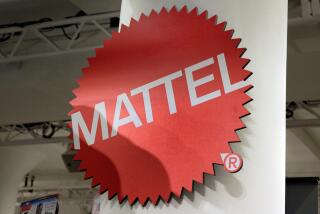Mattel to Buy Fisher-Price in $1-Billion Deal
Putting Barbie and a whole family of Little People under one roof, Mattel Inc. and Fisher-Price on Thursday announced a $1-billion merger that likely will make the combined company the nation’s No. 1 toy maker.
The alliance is expected to edge out Hasbro Inc., maker of G.I. Joe and an army of other products, for the top spot in the $10-billion worldwide toy market.
The deal, which will fold Fisher-Price into El Segundo-based Mattel, represents a coup for Mattel, which only a decade ago was a money-loser struggling to keep its dwindling share of the toy market. The Fisher-Price lineup gives bulk to Mattel’s muscle: The two companies last year had combined sales of about $2.542 billion, for a combined 15.3% worldwide market share. Hasbro last year had sales of about $2.541 billion and a 14.6% share of the toy market.
The agreement to merge was signed in late afternoon in New York, and Mattel Chairman John W. Amerman said he expects the stock-transfer merger to be complete by Dec. 1.
Each common share of Fisher-Price stock will be exchanged for 1.275 shares of Mattel stock. Amerman said the company will file within 10 days for approval under antitrust laws, but Amerman said he expects no opposition from the Justice Department.
Fisher-Price’s chairman, 49-year-old Ronald J. Jackson, took over the helm of the East Aurora, N.Y., company in 1990, the same year that its former owner, the Quaker Oats company, spun off Fisher-Price as a separate company. Jackson said Thursday he is committed to ensuring the success of the merger, but did not say whether he expected to stay after the merger was completed.
The companies said Fisher-Price will keep its New York headquarters. Amerman said there will be some staff reductions, but there had not been enough time to determine how many employees would be cut. Amerman said Mattel approached Fisher-Price “only five to six weeks ago” and that the merger had been negotiated quickly.
Mattel’s turnaround, begun in the mid-1980s with a cash infusion by a group of investors including new Los Angeles Mayor Richard Riordan, became a point of contention in this year’s mayoral race. Riordan cited his involvement with the company as an asset; his opponents castigated his involvement in the company’s decision in 1987 to close its last U.S. manufacturing plant in Paramount and move the jobs to Mexico.
Ironically, Mattel said it will achieve some of the cost savings it expects from the merger by using Fisher-Price’s two U.S. plants, at Murray, Ky., and Medina, N.Y., to manufacture more of the Mattel line of toys, primarily larger items currently made for Mattel by other manufacturers.
In a conference call late Thursday afternoon with chairmen Amerman and Jackson, securities analysts were frustrated in their attempts to determine exactly how and from where the company would achieve enough cost savings to keep its per-share earnings from falling next year.
Amerman said the company was not ready to disclose that information.
Afterward, analyst Craig Silvers of the Los Angeles securities firm of Crowell, Weedon said he had no doubt that the combined company could find enough in savings or extra sales to keep pace with Wall Street’s profit expectations.
Silvers and other analysts said the merger made perfect sense for Mattel.
Mattel specializes in the fantasy line of toys--with its Barbie and Hot Wheels products and toys based on Disney characters. Fisher-Price products, primarily aimed at the preschool and infant markets, have long been known for their high quality and educational values. They include the Little People and Puffalumps brands, riding toys and play-yard equipment.
Mattel has a worldwide sales network that Amerman said would now market Fisher-Price’s products. “We hope,” he said, “to put (Fisher-Price) teethers or rattlers in every newborn’s hand.”
The announcement of the merger was made after the closing of the New York Stock Exchange, and both companies’ stock closed unchanged, Mattel at $25.625 a share and Fisher-Price at $23.875 a share. But in after-hours trading, Fisher stock soared to $29 as investors reacted to the news.
Despite Mattel’s rebound in the last few years, investors had been wary of the company’s dependency on the Barbie line--despite Barbie’s apparently unassailable popularity for the last 34 years. Barbie currently accounts for half of Mattel’s worldwide sales, which reached $1.85 billion in 1992. In the combined company, Amerman said, Barbie products will account for just under 40% of sales.
In an interview, Amerman said the combination of the Mattel and Fisher-Price lines will make a “very strong products group, that transcends the toy industry--it is as good or better than any consumer products line.”
More to Read
Inside the business of entertainment
The Wide Shot brings you news, analysis and insights on everything from streaming wars to production — and what it all means for the future.
You may occasionally receive promotional content from the Los Angeles Times.










